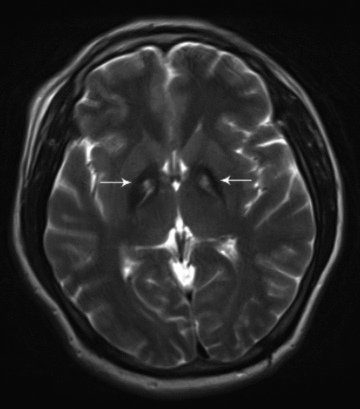Eye-of-the-Tiger sign is not Pathognomonic of Pantothenate Kinase-Associated Neurodegeneration in Adult Cases
- PMID: 22398981
- PMCID: PMC3217674
- DOI: 10.1002/brb3.8
Eye-of-the-Tiger sign is not Pathognomonic of Pantothenate Kinase-Associated Neurodegeneration in Adult Cases
Abstract
An eye-of-the-tiger sign is previously known to have one-to-one correlation with pantothenate kinase-associated neurodegeneration (PKAN). Reviewing the literature on this subject, the correlation between eye-of-the-tiger sign and PKAN seems to show an interesting hypothesis that differs from conventional conclusion. We analyze the published papers in an attempt to reflect this trend and illustrate our points with findings in a 39-year-old man. His brain magnetic resonance imaging study shows typical eye-of-the-tiger sign suggestive of PKAN. Genetic analyses revealed no mutations in pantothenate kinase 2.
Figures
Similar articles
-
Magnetic resonance imaging, susceptibility weighted imaging and quantitative susceptibility mapping findings of pantothenate kinase-associated neurodegeneration.J Clin Neurosci. 2019 Jan;59:20-28. doi: 10.1016/j.jocn.2018.10.090. Epub 2018 Nov 2. J Clin Neurosci. 2019. PMID: 30392836
-
Novel homozygous PANK2 mutation causing atypical pantothenate kinase-associated neurodegeneration (PKAN) in a Cypriot family.J Neurol Sci. 2014 May 15;340(1-2):233-6. doi: 10.1016/j.jns.2014.03.001. Epub 2014 Mar 11. J Neurol Sci. 2014. PMID: 24655737
-
The eye-of-the-tiger sign is not a reliable disease marker for Hallervorden-Spatz syndrome.Neuropediatrics. 2005 Jun;36(3):221-2. doi: 10.1055/s-2005-865714. Neuropediatrics. 2005. PMID: 15944911
-
Atypical pantothenate kinase-associated neurodegeneration: Clinical description of two brothers and a review of the literature.Rev Neurol (Paris). 2017 Dec;173(10):658-662. doi: 10.1016/j.neurol.2017.05.013. Epub 2017 Jun 16. Rev Neurol (Paris). 2017. PMID: 28629633 Review.
-
Atypical pantothenate kinase-associated neurodegeneration with PANK2 mutations : clinical description and a review of the literature.Neurocase. 2020 Jun;26(3):175-182. doi: 10.1080/13554794.2020.1752739. Epub 2020 Apr 20. Neurocase. 2020. PMID: 32310012 Review.
Cited by
-
Neurodegeneration with brain iron accumulation: diagnosis and management.J Mov Disord. 2015 Jan;8(1):1-13. doi: 10.14802/jmd.14034. Epub 2015 Jan 13. J Mov Disord. 2015. PMID: 25614780 Free PMC article. Review.
-
Rare Movement Disorders-An Approach for Clinicians.Int J Mol Sci. 2025 Jun 23;26(13):6024. doi: 10.3390/ijms26136024. Int J Mol Sci. 2025. PMID: 40649801 Free PMC article. Review.
-
Neurodegeneration with brain iron accumulation: a case series highlighting phenotypic and genotypic diversity in 20 Indian families.Neurogenetics. 2023 Apr;24(2):113-127. doi: 10.1007/s10048-023-00712-0. Epub 2023 Feb 15. Neurogenetics. 2023. PMID: 36790591
-
Eye-of-the-Tiger Sign with an Unexpected Pathological Diagnosis.Mov Disord Clin Pract. 2021 Nov 7;9(1):98-103. doi: 10.1002/mdc3.13366. eCollection 2022 Jan. Mov Disord Clin Pract. 2021. PMID: 35005073 Free PMC article.
-
The Case of a Patient with Pantothenate Kinase-Associated Neurodegeneration Presenting with a Prolonged History of Stuttering Speech and a Misdiagnosis of Parkinson's Disease.J Mov Disord. 2021 Jan;14(1):86-88. doi: 10.14802/jmd.20062. Epub 2020 Sep 21. J Mov Disord. 2021. PMID: 32942839 Free PMC article. No abstract available.
References
-
- Hartig MB, Hörtnagel K, Garavaglia B, Zorzi G, Kmiec T, Klopstock T, Rostasy K, Svetel M, Kostic VS, Schuelke M, Botz E, Weindl A, Novakovic I, Nardocci N, Prokisch H, Meitinger T. Genotypic and phenotypic spectrum of PANK2 mutations in patients with neurodegeneration with brain iron accumulation. Ann. Neurol. 2006;59:248–256. - PubMed
-
- Hayflick SJ, Westaway SK, Levinson B, Zhou B, Johnson MA, Ching H, Gitschier J. Genetic, clinical, and radiographic delineation of Hallervorden-Spatz syndrome. N. Engl. J. Med. 2003;348:33–40. - PubMed
-
- Kumar N, Boes CJ, Babovic-Vuksanovic D, Boeve BF. The “eye-of-the-tiger” sign is not pathognomonic of the PANK2 mutation. Arch. Neurol. 2006;63:292–293. - PubMed
-
- Strecker K, Hesse S, Wegner F, Sabri O, Schwarz J, Schneider JP. Eye of the tiger sign in multiple system atrophy. Eur. J. Neurol. 2007;14:e1–2. - PubMed
LinkOut - more resources
Full Text Sources


